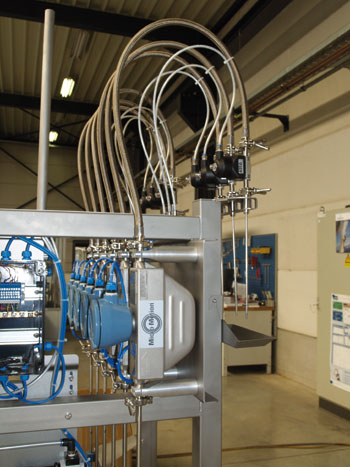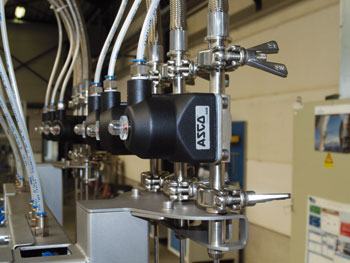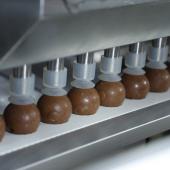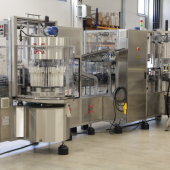Valves custom engineered for cartridge filling machines
Custom engineered aseptic diaphragm valves meet ATEX requirements and prevent ink contamination on cartridge filling machine
 When Sneyders Machineconstructie in Belgium, was asked to design, engineer and build an ink cartridge filling machine for a major manufacturer of industrial printing solutions, they chose ASCO Numatics to engineer and provide the custom valves required for the filling modules.
When Sneyders Machineconstructie in Belgium, was asked to design, engineer and build an ink cartridge filling machine for a major manufacturer of industrial printing solutions, they chose ASCO Numatics to engineer and provide the custom valves required for the filling modules.
These valves are a key element of the overall assembly and ASCO Numatics have the manufacturing and engineering resources to supply the special ATEX-approved, self-draining aseptic diaphragm valves that were required for this challenging application.
Co-engineering
Sneyders approached the ASCO Numatics applications team and asked them to quote for the special valves. Working with the customer’s design team, ASCO Numatics’ application engineers established a product specification covering the mechanical characteristics, dimensional details, end connections, positions of inlets and outlets, and compliance with standards, including ATEX certification.
Within two days, ASCO Numatics provided a Solidworx 3d drawing for the custom-engineered aseptic valve. This made it easy for Sneyders design team to check that the valves would fit within their compact design.
«The early availability of this drawing was a big benefit reducing the overall engineering time for the project» said Jef Broeckx, Sneyders. «The special valves were delivered from ASCO Numatics in just six weeks and this contributed to our success in meeting the challenging delivery schedule for this machine».
The technological solution
• The printing solution company manufactures industrial printers used to print barcodes, best before dates etc. as products are moving on a conveyor. The ink used by the printers is supplied in 750ml print cartridges and the company needed a machine to fill the cartridges with inks or a cleaning agent. Because the machine would be filling cartridges with different coloured inks it needed to be easily cleanable to prevent contamination.
Ensuring that the coloured inks being dispensed are not mixed is important and aseptic valves were chosen because they feature a self-draining design. This is critical because without this feature small pockets of ink would be left in the valves. This residue is difficult to remove and would require extensive cleaning to ensure any remaining ink is completely removed. ATEX-approved valves were required because the inks being dispensed are flammable, while to ensure compatibility with other connection flanges on the machine, the valves needed to be supplied with special flanges. This removed the need for adaptors to be used with the valves, which would have added to the cost and engineering time for the project.
• Sneyders Machineconstructie, part of Seamco, is a leading supplier of bottling and packaging equipment. The company specialises in the manufacture of linear filling machinery suitable for a wide range of applications, including the bottling of oils, soaps, detergents, body care and chemical products
Sneyders solution for the print cartridge filling application was a machine based on both customised modules and bespoke elements. The filling application requires highly accurate and consistent results with fast filling rates and Sneyders selected Emerson’s Micro Motion sanitary flowmeters based on Coriolis technology for mass flow measurement. Two interchangeable filling modules allow one module to be in use while the other is being cleaned.
A programmable logic controller (PLC) provides overall control of the machine.
«ASCO Numatics were able to translate our special requirements for control valves into delivered products very quickly» continued Jef Broeckx, Sneyders. «Even when the project scope was amended at a late stage and two additional valves were required, the additional valves, complete with bespoke ends, were delivered in just 2 weeks».
Understanding drain-ability in process valves
One of the most important criteria for all valves applied to aseptic processes is their drain-ability. This is the reason why diaphragm valves have prevailed as the valve of choice for aseptic process applications. To achieve optimum self-draining for horizontally installed valves, the following criteria must be taken into account:
• Correct design and inner contours of the two-way body;
• Internal surface quality of the two-way body;
• Cavity free valve assembly;
• Self-draining installation position;
• End connections;
• Slope of the installed two-way body;
• Consistency of the media.
The system designer and end user need to take care that the drain-ability requirements of the valve are met. For example, it is essential that the valve is installed at a specific angle allowing the media to fully drain in the open position.
For optimum drain-ability, it is recommended that the tubing and valves are installed with a 1% (10 mm/m) slope for long runs and 2% (20 mm/m) slope for short runs. This ensures the complete drain-ability of the process system.
If required, the tube end of the valve body can be marked so that when installed correctly, the mark crosses the centreline of the tube end and be perpendicular to the pipe line. In addition, a drain tool accessory may be supplied for easy installation and adjustment of the drain angle.




















